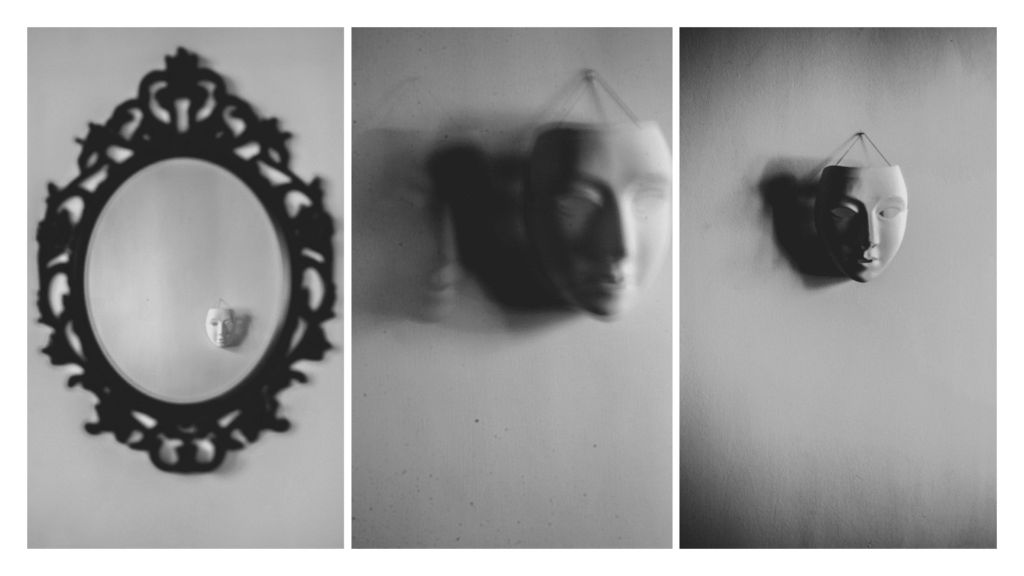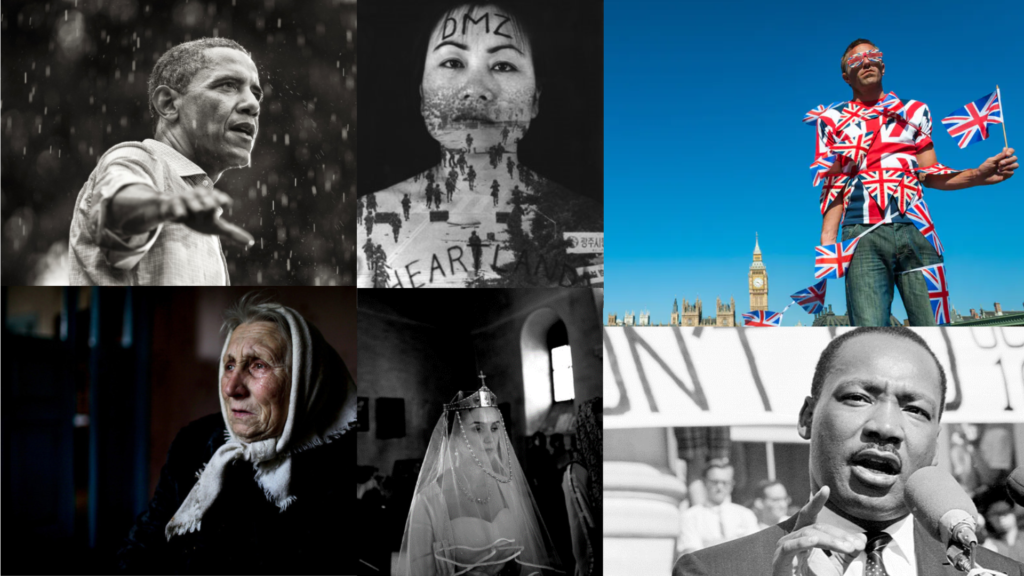
What is Identity?
The definition of identity is who you are, the way you think about yourself, the way you are viewed by the world and the characteristics that define you. An example of identity is a person’s name, however a deeper meaning of identity could imply the qualities, beliefs, personality, looks and/or expressions that make a person or group. Categorizing identity can be positive or destructive. A psychological identity relates to self-image, self-esteem, and individuality. Since its origins photography has enabled people to make sense of themselves and their environment. In one sense all photography, whether it is directly about the photographer or not, is an exploration of identity and/or place and can be separated in the following categories…
Geographical/Political
…translates as being based on or derived from the physical features of an area but can also relate to cultures, races, and traditions that are accustomed to such areas, regions or countries. Political on the other hand defines as relating to the government or public affairs of a country. Both categories are similar in some respect and merge together well as one theme for this project.
Gender Identity
…is the personal sense of one’s own gender. Gender identity can correlate with assigned sex at birth or can differ from it. All societies have a set of gender categories that can serve as the basis of the formation of a person’s social identity in relation to other members of society.
Culture
…is an umbrella term which encompasses the social behavior and norms found in human societies, as well as the knowledge, beliefs, arts, laws, customs, capabilities and habits of the individuals in these groups.
Society
…can relate to a group of individuals involved in persistent social interaction, or a large social group sharing the same spacial or social territory, typically subject to the same political authority and dominant cultural expectations
Loss of Identity
…can be perceived as personal psycho-social conflict especially in adolescence that involves confusion about one’s social role and often a sense of loss of continuity to one’s personality.

Identity Series By Polish Photographer Michalina Woźniak
The Project
For my project, I have chosen to explore the theme of geographical/political identity, aiming to take photos with the intent of expressing geographical aspects such as race, culture and how places/environments can affect lifestyles and the outcome of people and its influences on their success in life, whether it be high or low. In addition to that, I will try to also include political themes, capturing the political views of people, and the effect it has on them and others around them, as well as similarly to the geographical aspects, highlighting different races, cultures and how politics affects them as well as how society both shapes and perceives them.

The definition of identity is: the fact of being who or what a person or thing is, a close similarity or affinity. I am inspired by this definition because it will enable me to look at a variety of photographers and will prompt me to question my own identity. During this project I will explore the works of other individuals who inspired me and photographed similar themes of identity and aim to express these elements through a variety of photographic techniques.
Inspiration – Diana Markosian

Diana Markosian is an American and Russian artist of Armenian descent, working as a documentary photographer, writer, and filmmaker. She is known for her photo essays, including Inventing My Father, about her relationship with her father, and 1915, about the Armenian genocide. Her work has inspired me to take a similar approach in my photography during this part of the project, aiming to highlight geographical and political aspects through my photography just like hers. Diana Markosian is an artist known for her experimental approach to storytelling, using photography and video. Her work is both conceptual and documentary and can be found in publications like National Geographic Magazine, The New Yorker and The New York Times. She holds a Master of Science from Columbia University in New York.
“My commitment and passion for this profession doesn’t come from simply creating images. It comes from building relationships. You have to be a person before you are a photographer.”
Markosian was born in Moscow. In 1996, she moved to California with her mother and her brother, while her father remained in Russia.She had no contact with him until 23, when she found her father in Armenia, after 15 years of being apart. Markosian graduated from the University of Oregon with a bachelor of arts in history and international studies in 2008, and earned a Master of Science from Columbia University’s Graduate School of Journalism in 2010 at the age of 20.
Her Work
This is a brief introduction to Markosian’s work, a handful of selected images that I thought best fit the theme of geographic/political identity. These photos as well as many more can be found on Markosian’s personal website where you can find her portfolios for different projects she has completed over the years as well as commisions for world renowned news outlets such as National Geographic, the BBC, The New Yorker and The New York Times.
Her work is often presented in a photo-essay style, where she posts a handful of her best images she has taken along her journey, and gives them very brief descriptions of context below, often describing her journey and what she has found, recalling accounts of local people and always sharing a moral of a story. These stories usually relate to the theme of cultural/geographical/political identity. Great examples of her photo-essays are…
- http://www.dianamarkosian.com/1915
- http://www.dianamarkosian.com/the-virgin-mary
- http://www.dianamarkosian.com/goodbye-my-chechnya
- http://www.dianamarkosian.com/quince
- http://www.dianamarkosian.com/father

In Chechnya, (a Russian republic explored by Markosian in one of her projects), she says how “couples must meet in public and sit a distance from one another. All physical contact is forbidden before marriage”. This highlights cultural and regional differences, as a result of many factors, geography and politics often being the main reason for these.

Markosian is a skilled artist, her photos have a clear meaning and intent. This photo simply shows the cultural and religious differences of Chechnya, placing herself right in front of the Heart of Chechnya mosque, the largest in Europe, highlighting Chechnya’s Islamic beliefs, a contrast from the country of Russia which mainly practices Orthodox Christian.

Most of her photos capture differences that can be observed worldwide, often religious, political and always geographical. Through her photography, cultural anomalies shine through, and thus makes her photography not only unique, but very interesting to glance at.

Aspects of Markosian’s Photography
Technical
The images purposefully doesn’t use loads of clever techniques in order to create a sense of realism, instead they use natural light which creates this darker tone to the image with higher contrasts. To add to that her images often seem to have short exposures which also further adds to the dark, contrasts seen in her photos. The images also often have some depth of field which creates a distinguishable foreground and background to the image. Additionally, the composition of her photos are often symmetrical, as as well as generally being very well focused, highlighting detail in the foreground and a subtle blur in the background, however the blur isn’t always used by Markosian.
Visual
Her images vary considerable throughout her work. In the photo above, the dark tones are also apparent due to the lack of lighting, with faint yellows coming through from the background lighting, adding variety to her photographs. The composition is very natural, and fits with her style of realism as the photographer didn’t set the image up and so the image has the appearance which works very well with their project.
Contextual
This photo was taken as part of Marksoian’s project, “The Virgin Mary” which she completed in 2015 and can be seen here… http://www.dianamarkosian.com/the-virgin-mary
In the photo, Markosian finds herself in the middle of worshipers gathering outside a monastery in Minya in anticipation of an apparition. The project was to discover what occurs in religious pilgrimages and the people who part-take i them.
Project Ideas
For my exam piece I was thinking of getting a plain book and presenting my final photographs of which I hope to have at least 10 in chronological order in a photo-essay style as famously presented like Markosian’s work. I will organise them into these mini stories made up of primarily photos with small, concise descriptions of context underneath, just like Markosian. I will also base it on the people’s life experiences of coming to the island from abroad or those who were born and bred on the island and their political views on immigration and similar topics as explored by Markosian.
These photos will be inspired by Markosian’s style of photography, exploring the theme of realism and implementing similar photographic techniques with the intent of showing cultural/geographical/political differences within the small island of Jersey to show the diverse community we live in. This is not purely about showing different ethnic groups, religions and cultures, but also aims to manifest the thoughts, and political views of such individuals too.
Photo Shoot Plan
WHO:
Take photos of friends, showing different cultures, race, religions, political views and ethnicity that may flourish from such individuals, with the intent of highlighting diversity within the population. I’ll also try to photograph certain events that link to any of the criteria above, such as cultural festivals, religious events, political movements/protests etc.
WHAT:
The images I am going to create will be in the Markosian’s style of identity photography which has heavily inspired me.
WHERE:
In Jersey, it’s quite vague to distinguish one particular spot to photograph any of the criteria as it can be found everywhere.
WHY:
I am taking the images to explore the idea of identity, whether it is cultural, religious or geographical identity and as an effective set of identity images for my exam.
HOW:
With a DSLR camera placed on a tripod or mobile phone, which will be taken in various environments to give a suitable background/backdrop.
